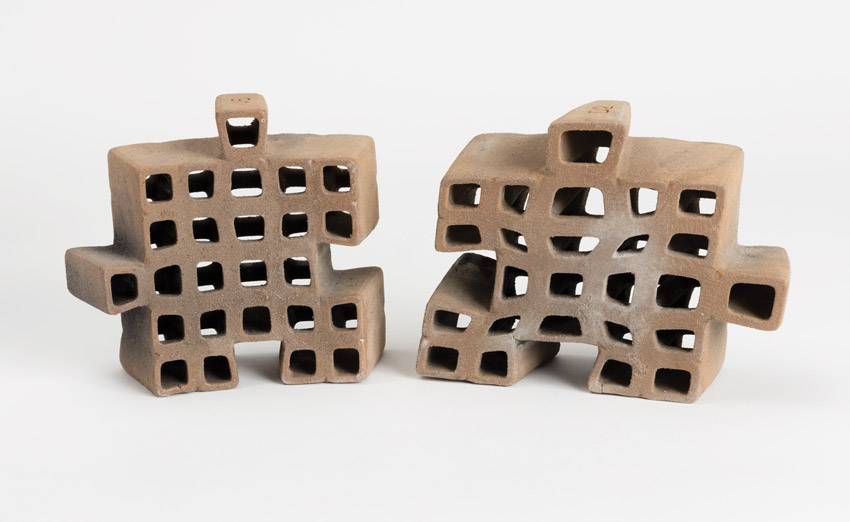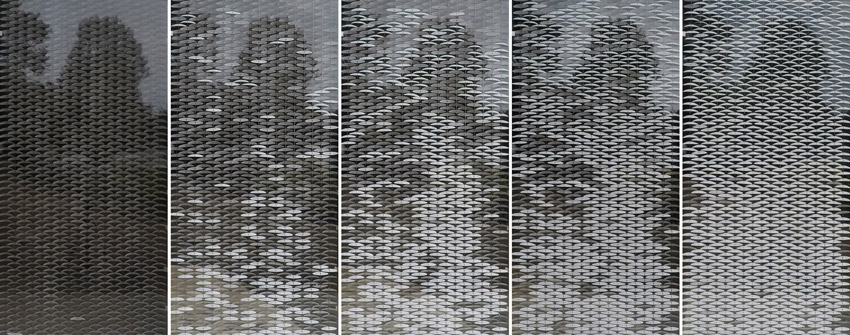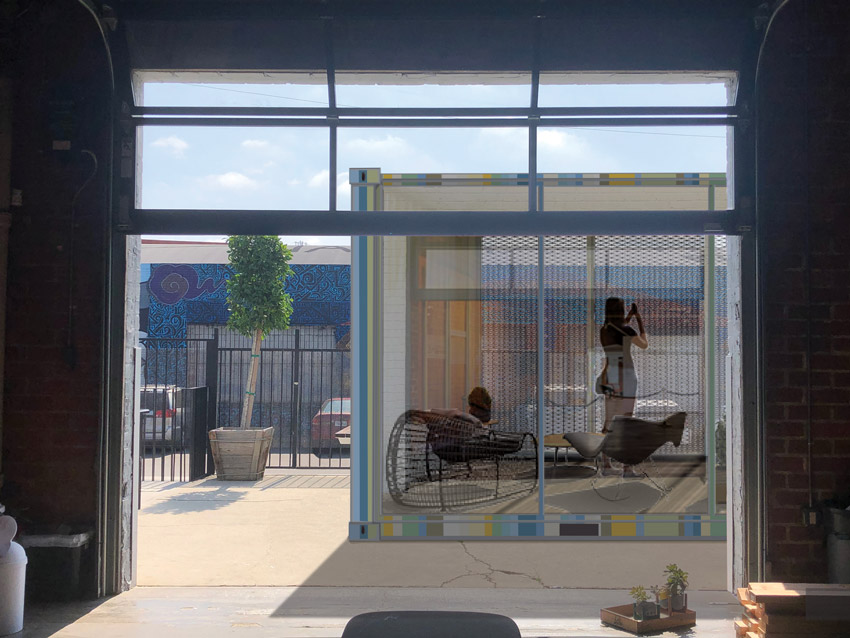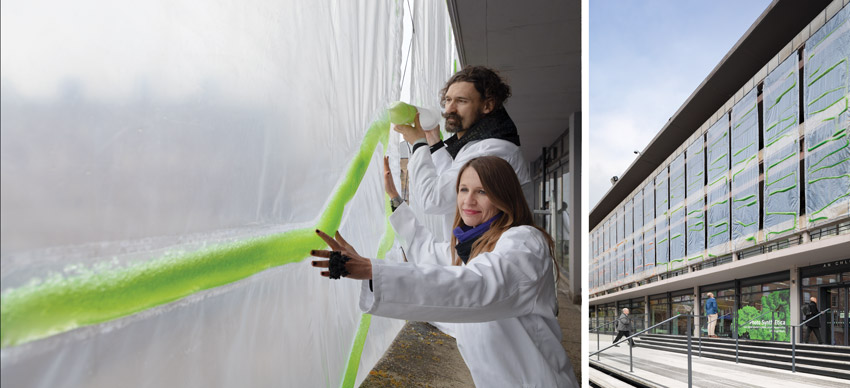Recent innovations in brick also demonstrate biomimetic structural hierarchies. “Bricks have not changed in millennia,” says Jenny Sabin, professor and researcher at Cornell University’s College of Art, Architecture, and Planning, and principal of Jenny Sabin Studio. “But now, with 3-D printing, every single brick can be different,” she says. In a product series called Polybrick 1.0, Sabin’s interdisciplinary lab developed the algorithmic design and additive manufacturing of cellular-form brick for mortarless assembly and mass customization. Subsequent collaborations led to the development of bricks generated according to the principles of human bone formation: Polybrick 2.0 generates osteoid bricks with densely structured lattices for use where loads are greatest, at the base of a wall, and increasingly porous lattices as loads lighten toward the top. A further series, Polybrick 3.0, incorporates synthetic DNA as a “programmable glaze.” It emits bioluminescence in nano- to macro-scale patterns of the designers’ choosing. Ultimately Sabin sees this technology having the potential to signal the presence of certain air contaminants (and perhaps even to mitigate them), or to encode data to facilitate self-assembly.
With this, the series is beginning to manifest other quintessentially biological characteristics: sensing, responding, and adapting. Sabin’s studio’s most recent work, Ada, a project developed within Microsoft Research’s Artist in Residence program, takes these characteristics even further.
Now installed at the company’s campus in Redmond, Washington, Ada is “a pavilion of knitted light,” says Sabin, “a cyber-physical architecture that immerses visitors in an interactive glow of photoluminescence.” Its lightweight, digitally knitted structure consists of responsive and data-driven tubular and cellular components. Sensors in the pavilion and throughout the building collect indications of emotion, such as facial patterns and voice tones, from visitors choosing to participate. Artificial intelligence (AI) processes the data, and scripts developed in Sabin’s architecture firm translate it into three different scales of lighting that transform Ada’s responsive materials (such as textiles and photoluminescent fibers) to reflect individual and collective sentiment. “It’s an interactive, human-centered project that celebrates AI,” says Sabin, “an architecture that is happy to see you and smiles back at you.”

PHOTOGRAPHY: COURTESY SABIN DESIGN LAB, CORNELL UNIVERSITY
Jenny Sabin’s Polybrick series includes a mortarless masonry system developed with an algorithmic design (top) and bricks that have dense structural lattices for use where loads are greatest and more porous lattices for other areas (bottom).
Where Ada deploys sensors and AI to elicit a material response to affect-based inputs, the work of DO|SU Studio (San Francisco) relies on inherently responsive smart materials, such as thermobimetal, to create dynamic building envelopes that help to regulate conditions in the interiors. Thermobimetal consists of two metal alloys laminated together, each with a different coefficient of expansion; as temperature rises, one side expands more quickly than the other, and the material curls. Using alloys of nickel, manganese, iron, and copper, DO|SU has developed assemblies that make the most of the material’s kinetic properties to mimic the way living things respond to the sun—opening and closing—all without electricity or external control systems.
“It’s fantastic,” says Doris Sung, the firm’s principal. “Here we are, dealing with global warming and the need to conserve energy, and we can actually make a material that reacts to changes in temperature autonomously.”
A result of DO|SU’s wide-ranging research into self-shading, self-ventilating, self-assembling, and self-propelling projects, InVert, an insulated glazing unit, is now market-ready. Its integrated shading device consists of a matrix of small, leaf-like pieces of thermobimetal inserted as an interlayer between the panes. As the pieces heat up in the sun, they toggle on a little pivot to lie perpendicular to the sun angle, shading the inner pane; as the sun moves on (or, rather, as the earth turns) and the pieces cool, they toggle back. Eliminating the need for films or coatings, the system achieves a heat-gain coefficient of 0.37 while maintaining 70 percent visibility and admitting full-spectrum daylight even in shading mode. In addition to its functional contribution to the building skin, InVert contributes biophilic qualities as well. It provides a dynamic index of outdoor conditions for people inside the building, connecting them to their environment, and, because the pieces operate individually rather than all at once, “it’s almost like leaves fluttering on a tree,” says Sung.

COURTESY SABIN DESIGN LAB, CORNELL UNIVERSITY
One of the best-known examples of a biological process is photosynthesis, the method by which plants use solar energy to convert water, carbon dioxide, and minerals into oxygen and carbohydrates. In a hybrid example of biomimicry and bio-utilization, a building-skin material developed by London-based ecoLogicStudio integrates algae (whose photosynthesis produces about half of our atmospheric oxygen) into a membrane that serves as a shading device or cladding while enabling buildings to improve urban air quality.
“When you think of technology as something that is not separated from society, but embedded in it, architecture—and the city—is the perfect vehicle,” says Marco Poletto, cofounder with Claudia Pasquero of ecoLogic. “It exists in between, as a kind of interface between technology and life.” As an interface in itself at a finer level of scale, Photo.Synth.Etica, as the cladding system is called, comprises three components: hardware (the membrane—now ETFE, with a 3-D-printed, bio-based iteration under development), wetware (a watery medium supporting a culture of microalgae, which can be configured to make a meaningful contribution to the building design), and software (which encompasses design, as well as monitoring and management).
It works by admitting unfiltered city air at the bottom of each biomodule; as the air bubbles naturally through the wetware, CO2 molecules and air pollutants are captured and stored by the algae, which grows into a biomass that will contribute to existing supply chains for biofuel, pharmaceutical, bioplastic, or—since a teaspoon of spirulina contains the same amount of protein as a T-bone steak—nutritional uses. Air is then returned, filtered and oxygen enriched, from the top of each module to the city.

PHOTOGRAPHY: © NAARO
DO|SU Studio’s InVert insulated glazing units incorporate leaf-like pieces of thermobiometal (above). As the pieces heat up in the sun, they toggle to provide shade. Even in shading mode (below), visibility to the exterior is maintained.

When Photo.Synth.Etica was retrofitted, bannerlike, onto a two-story section of the facade of the Printworks at Dublin Castle, during that city’s 2018 climate innovation summit, it captured CO2 from the atmosphere at an estimated kilogram per day—equivalent to 20 large trees. A subsequent installation in Helsinki earlier this year configured the photo-bioreactors more densely on the membrane and then shaped and distributed the components across the facade, in a design that remained effective from a functional perspective while responding aesthetically to its new context. “Of course the project contributes to the consumption of CO2 and the production of oxygen and protein, but it can also contribute to the psychology of the city,” says Pasquero, “so aesthetics are important.” Currently available for custom applications in collaboration with ecoLogicStudio, Photo.Synth.Etica is expected to launch commercially in late 2020.

A membrane that integrates algae (left) and can be configured to provide shading while improving urban air quality has been developed by ecoLogicStudio. The system appeared on a facade in Dublin during a 2018 climate innovation summit (right).
These examples of innovative materials—from carbon-sequestering structures to sensing and responsive skins—suggest the biomimetic paradigm’s profound potential. Yet obstacles to its widespread development and uptake remain. “We live in a bizarre age in which we have all the solutions we need to make very rapid progress on tackling climate change and reversing biodiversity loss,” says Pawlyn, “but it’s not happening at anywhere near the pace that it should be.” He used to think it was fairly straightforward things we need to get better at, like advancing the economic arguments and building some exemplary projects. About a year ago, however, he reached the conclusion that the problem exists at a higher, systemic level. To induce rapid change, we need, on the one hand, more adventurous exemplars and material-research projects like those profiled here, and, on the other, he says, “some radical re-thinking of the metaphors, values, and systems by which we live.”
Supplemental Materials
Using Nature’s Genius in Architecture, Michael Pawlyn/TED Salon London 2010
Katharine Logan is a designer and writer focusing on architecture, sustainability, and well-being.
View course on architecturalrecord.com »
The earth’s biological materials and the processes through which they’re generated represent the fruits of about 3.8 billion years of research and development. As our species approaches the limits of the earth’s carrying capacity, there’s a lot humans can learn from them. That’s the basic premise of biomimicry—design inspired by the way functional challenges have been solved in biology.

PHOTOGRAPHY: © JOHN BRECHER FOR MICROSOFT
Jenny Sabin’s Ada, a digitally knitted enclosure, is equipped with sensors enabling its photo-luminescent fibers to transform and respond to visitors.
Biomimicry’s emphasis on problem solving distinguishes it from related concepts, such as biophilia (the hypothesis that humans have an innate need for connections with nature and other forms of life), biomorphism (design based on nature’s shapes and forms), bio-utilization (the direct use of nature—in green infrastructure, for instance), and bio-inspired design (a catch-all). The ideas these terms represent are distinct yet compatible, and a given scheme may combine more than one of them.
Biomimicry can generate solutions to a gamut of design challenges ranging from green chemistry to organizational development. But of particular interest for architects are biomimetic construction materials and the ways they are leading to more sustainable—and even regenerative—buildings. For example, looking to nature for ways to curb runaway carbon emissions reveals that biological processes kept pre-anthropogenic levels of atmospheric carbon dioxide confined within a narrow band for hundreds of thousands of years. That’s probably because, as CO2levels increased, blooms of coccoliths—marine microorganisms that form their skeletons from calcium carbonate, and become limestone when they die—transferred carbon from the atmosphere to the earth’s crust, regulating the balance. “Biology would solve the problem of climate change by making a lot more stuff out of atmospheric carbon,” says Michael Pawlyn, author of Biomimicry in Architecture and founding principal at London-based Exploration Architecture.
The BioRock Pavilion, Exploration Architecture’s concept for a small auditorium, does just that. BioRock, a technology originally developed by marine scientists and used in the restoration of coral reefs, grows limestone in seawater by running a low-voltage current through steel filaments; the current causes a chemical reaction that deposits carbon-sequestering limestone along the armature. And unlike, say, concrete manufacturing (which is responsible for 4 to 8 percent of the world’s CO2 emissions), this natural carbon-sequestering process is environmentally benign.
“There’s much to be gained from looking at the way materials are assembled in biology,” says Pawlyn, listing some of the key principles: low-energy production with locally available materials, the absence of persistent and bioaccumulative toxins, and interconnections within a closed-loop system in which everything can be—and is—reused.
A product generated according to these principles—in a process developed by Brent Constantz, founder of Blue Planet, a Los Gatos, California, company focused on economically sustainable carbon capture—is already being used commercially. Blue Planet grows carbon-sequestering aggregate for use in concrete or roadbeds by converting CO2 from the air or from flue gas—often from cement plants—into limestone. Instead of a current-charged wire armature, Blue Planet uses rock particles from solid industrial waste (such as concrete-demolition debris) to provide a nucleus around which limestone builds in water-based mineral solutions to sizes ranging from sand to gravel.
Because the aggregate’s carbon-sequestering coating is 44 percent CO2 by mass, the material completely mitigates the carbon emitted in the production and transport of the concrete it’s part of—and then some—to produce carbon-negative concrete: 3,000 pounds of aggregate in a cubic yard of concrete could sequester 1,320 pounds of carbon, more than offsetting the 300 to 600 pounds of embodied carbon the concrete would typically represent. It has been used in such projects as the San Francisco International Airport, and, if it were substituted for all 50 billion tons of aggregate quarried each year worldwide, it would sequester more than half the world’s annual anthropogenic carbon emissions, bringing atmospheric carbon down to preindustrial levels by 2050 singlehandedly, according to an estimate from the Foundation for Climate Restoration. With production facilities able to locate near ready-mix operations, the cost is generally less than that of quarried and transported aggregate, says Constantz, so the main challenge to widespread adoption is Blue Planet’s ability to open enough plants.
In addition to growing material by the strategic and adaptive accretion of available substances, biology tends to generate efficient but spectacularly complex, hierarchically organized systems to efficiently carry loads with minimal structure—an idea neatly summed up in an aphorism attributed to biologist and retired academic Julian Vincent: “In biology, material is expensive, and shape is cheap.”

PHOTOGRAPHY: KELLY HILL PHOTOGRAPHY
Exploration Architecture’s proposal for a crow-skull-inspired pavilion (left), depends on additive-manufacturing processes to place material precisely where it is needed. The firm’s concept for an auditorium (right) uses a technology originally developed to restore coral reefs.
One of the most elegant examples is birds’ skulls, for which evolution has prioritized lightness. Built up of fine layers of bone connected by tiny struts, they combine dome and space-frame technologies, says Pawlyn, whose crow’s-skull-inspired pavilion, now in design (with a still-confidential commission in the offing), demonstrates the principle. “Conventionally, it’s been very difficult to mimic the complexity of biology without a huge cost penalty,” he says. But now, with additive manufacturing processes placing material precisely and only where it’s needed, there’s no cost premium, says Pawlyn, “and there is actually the potential to save money by using less material.”
Recent innovations in brick also demonstrate biomimetic structural hierarchies. “Bricks have not changed in millennia,” says Jenny Sabin, professor and researcher at Cornell University’s College of Art, Architecture, and Planning, and principal of Jenny Sabin Studio. “But now, with 3-D printing, every single brick can be different,” she says. In a product series called Polybrick 1.0, Sabin’s interdisciplinary lab developed the algorithmic design and additive manufacturing of cellular-form brick for mortarless assembly and mass customization. Subsequent collaborations led to the development of bricks generated according to the principles of human bone formation: Polybrick 2.0 generates osteoid bricks with densely structured lattices for use where loads are greatest, at the base of a wall, and increasingly porous lattices as loads lighten toward the top. A further series, Polybrick 3.0, incorporates synthetic DNA as a “programmable glaze.” It emits bioluminescence in nano- to macro-scale patterns of the designers’ choosing. Ultimately Sabin sees this technology having the potential to signal the presence of certain air contaminants (and perhaps even to mitigate them), or to encode data to facilitate self-assembly.
With this, the series is beginning to manifest other quintessentially biological characteristics: sensing, responding, and adapting. Sabin’s studio’s most recent work, Ada, a project developed within Microsoft Research’s Artist in Residence program, takes these characteristics even further.
Now installed at the company’s campus in Redmond, Washington, Ada is “a pavilion of knitted light,” says Sabin, “a cyber-physical architecture that immerses visitors in an interactive glow of photoluminescence.” Its lightweight, digitally knitted structure consists of responsive and data-driven tubular and cellular components. Sensors in the pavilion and throughout the building collect indications of emotion, such as facial patterns and voice tones, from visitors choosing to participate. Artificial intelligence (AI) processes the data, and scripts developed in Sabin’s architecture firm translate it into three different scales of lighting that transform Ada’s responsive materials (such as textiles and photoluminescent fibers) to reflect individual and collective sentiment. “It’s an interactive, human-centered project that celebrates AI,” says Sabin, “an architecture that is happy to see you and smiles back at you.”

PHOTOGRAPHY: COURTESY SABIN DESIGN LAB, CORNELL UNIVERSITY
Jenny Sabin’s Polybrick series includes a mortarless masonry system developed with an algorithmic design (top) and bricks that have dense structural lattices for use where loads are greatest and more porous lattices for other areas (bottom).
Where Ada deploys sensors and AI to elicit a material response to affect-based inputs, the work of DO|SU Studio (San Francisco) relies on inherently responsive smart materials, such as thermobimetal, to create dynamic building envelopes that help to regulate conditions in the interiors. Thermobimetal consists of two metal alloys laminated together, each with a different coefficient of expansion; as temperature rises, one side expands more quickly than the other, and the material curls. Using alloys of nickel, manganese, iron, and copper, DO|SU has developed assemblies that make the most of the material’s kinetic properties to mimic the way living things respond to the sun—opening and closing—all without electricity or external control systems.
“It’s fantastic,” says Doris Sung, the firm’s principal. “Here we are, dealing with global warming and the need to conserve energy, and we can actually make a material that reacts to changes in temperature autonomously.”
A result of DO|SU’s wide-ranging research into self-shading, self-ventilating, self-assembling, and self-propelling projects, InVert, an insulated glazing unit, is now market-ready. Its integrated shading device consists of a matrix of small, leaf-like pieces of thermobimetal inserted as an interlayer between the panes. As the pieces heat up in the sun, they toggle on a little pivot to lie perpendicular to the sun angle, shading the inner pane; as the sun moves on (or, rather, as the earth turns) and the pieces cool, they toggle back. Eliminating the need for films or coatings, the system achieves a heat-gain coefficient of 0.37 while maintaining 70 percent visibility and admitting full-spectrum daylight even in shading mode. In addition to its functional contribution to the building skin, InVert contributes biophilic qualities as well. It provides a dynamic index of outdoor conditions for people inside the building, connecting them to their environment, and, because the pieces operate individually rather than all at once, “it’s almost like leaves fluttering on a tree,” says Sung.

COURTESY SABIN DESIGN LAB, CORNELL UNIVERSITY
One of the best-known examples of a biological process is photosynthesis, the method by which plants use solar energy to convert water, carbon dioxide, and minerals into oxygen and carbohydrates. In a hybrid example of biomimicry and bio-utilization, a building-skin material developed by London-based ecoLogicStudio integrates algae (whose photosynthesis produces about half of our atmospheric oxygen) into a membrane that serves as a shading device or cladding while enabling buildings to improve urban air quality.
“When you think of technology as something that is not separated from society, but embedded in it, architecture—and the city—is the perfect vehicle,” says Marco Poletto, cofounder with Claudia Pasquero of ecoLogic. “It exists in between, as a kind of interface between technology and life.” As an interface in itself at a finer level of scale, Photo.Synth.Etica, as the cladding system is called, comprises three components: hardware (the membrane—now ETFE, with a 3-D-printed, bio-based iteration under development), wetware (a watery medium supporting a culture of microalgae, which can be configured to make a meaningful contribution to the building design), and software (which encompasses design, as well as monitoring and management).
It works by admitting unfiltered city air at the bottom of each biomodule; as the air bubbles naturally through the wetware, CO2 molecules and air pollutants are captured and stored by the algae, which grows into a biomass that will contribute to existing supply chains for biofuel, pharmaceutical, bioplastic, or—since a teaspoon of spirulina contains the same amount of protein as a T-bone steak—nutritional uses. Air is then returned, filtered and oxygen enriched, from the top of each module to the city.

PHOTOGRAPHY: © NAARO
DO|SU Studio’s InVert insulated glazing units incorporate leaf-like pieces of thermobiometal (above). As the pieces heat up in the sun, they toggle to provide shade. Even in shading mode (below), visibility to the exterior is maintained.

When Photo.Synth.Etica was retrofitted, bannerlike, onto a two-story section of the facade of the Printworks at Dublin Castle, during that city’s 2018 climate innovation summit, it captured CO2 from the atmosphere at an estimated kilogram per day—equivalent to 20 large trees. A subsequent installation in Helsinki earlier this year configured the photo-bioreactors more densely on the membrane and then shaped and distributed the components across the facade, in a design that remained effective from a functional perspective while responding aesthetically to its new context. “Of course the project contributes to the consumption of CO2 and the production of oxygen and protein, but it can also contribute to the psychology of the city,” says Pasquero, “so aesthetics are important.” Currently available for custom applications in collaboration with ecoLogicStudio, Photo.Synth.Etica is expected to launch commercially in late 2020.

A membrane that integrates algae (left) and can be configured to provide shading while improving urban air quality has been developed by ecoLogicStudio. The system appeared on a facade in Dublin during a 2018 climate innovation summit (right).
These examples of innovative materials—from carbon-sequestering structures to sensing and responsive skins—suggest the biomimetic paradigm’s profound potential. Yet obstacles to its widespread development and uptake remain. “We live in a bizarre age in which we have all the solutions we need to make very rapid progress on tackling climate change and reversing biodiversity loss,” says Pawlyn, “but it’s not happening at anywhere near the pace that it should be.” He used to think it was fairly straightforward things we need to get better at, like advancing the economic arguments and building some exemplary projects. About a year ago, however, he reached the conclusion that the problem exists at a higher, systemic level. To induce rapid change, we need, on the one hand, more adventurous exemplars and material-research projects like those profiled here, and, on the other, he says, “some radical re-thinking of the metaphors, values, and systems by which we live.”
Supplemental Materials
Using Nature’s Genius in Architecture, Michael Pawlyn/TED Salon London 2010
Katharine Logan is a designer and writer focusing on architecture, sustainability, and well-being.



















